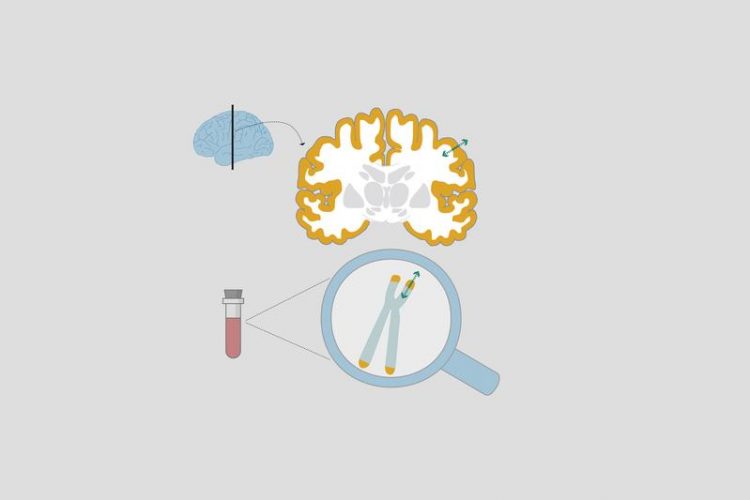Cellular aging is linked to structural changes in the brain

To determine the role of telomer length on brain structure scientists measured their length with the DNA of leukocytes from the blood using a polymerase chain reaction. MPI CBS
Telomeres are protective caps at the ends of chromosomes that become shorter with each cell division. If they become so short that the genes they protect could be damaged, the cell stops dividing and renewing. Consequently, the cell is increasingly unable to perform its functions. This mechanism is one of the ways in which we age.
Telomere length is therefore regarded as a marker for the biological age of a person — in contrast to their chronological age. For two people of the same chronological age, the person with shorter telomeres has an increased risk of developing age-related diseases such as Alzheimer's or cancer, and even a shorter life expectancy.
Telomere lengthening
One key to staying younger longer therefore seems to be related to the question: How do we slow down, stop, or even reverse the shortening of telomeres? Genetics and unhealthy lifestyle are important contributors to telomere shortening, along with psychological stress.
Based on this knowledge, researchers have examined how much lifestyle can influence telomere length. Recent studies suggest that telomeres can change faster than previously thought, possibly taking just one to six months of mental or physical training to elongate. The exciting premise is that telomere lengthening may represent a reversal of biological aging processes. However, it remains unclear if telomere elongation actually reflects any improvement in a person’s overall health and aging trajectory.
“To explore whether a short-term change in telomere length, after only a few months, might actually be associated with changes in a person's biological age, we linked it to another biomarker of aging and health: brain structure,” explains Lara Puhlmann, now a member of the Research Group 'Social Stress and Family Health' led by Veronika Engert at the Leipzig Max Planck Institute. The project had been initiated by Tania Singer as part of the ReSource Project.
Participants of the researchers’ study underwent four MRI examinations, each spaced three months apart, and provided blood samples on the same dates. Using the DNA of leukocytes from the blood, the scientists were able to determine telomere length using a polymerase chain reaction. The MRI scans were used to calculate the thickness of the cerebral cortex of each participant. This outer layer of grey matter becomes thinner with age. It is also known that some neurological and age-related diseases are associated with faster cortical thinning in certain brain regions.
Fast changes in biological aging
The result: “Across systems, our biological aging appears to change more quickly than we thought. Indices of aging can vary together significantly in just three months,” says Puhlmann. If the telomeres changed in length, this was associated with structural changes in the brain. In a period when participants’ telomeres lengthened during the study, it was also more likely that their cortex had thickened at the same time. On the other hand, telomere shortening was associated with reductions of grey matter. This association occurred specifically in a brain region called the precuneus, which is a central metabolic and connectional hub.
The above results suggest that even short-term changes in telomere length over just three months might reflect general fluctuations in the body’s health- and aging status. Many other questions, however, remain open. “We do not know, for example, which biological mechanism underlies the short-term changes in telomere length”, explains the scientist, “or whether the short-term changes really have a longer-term effect on health.”
Mental training
At the same time, the team of researchers investigated whether telomere length could be altered by nine months of mindfulness- and empathy-based mental training, and whether such systematic change in telomere length would also be reflected in cortical thickening or thinning. Previous data from the ReSource Project, which was supported by the European Research Council (ERC), had already shown that certain regions of the cortex can be thickened by training, depending on the respective mental training contents of three distinct modules, each lasting for three months. The physiological stress response could also be reduced by mental training with social aspects.
In contrast to their earlier work and previous findings from other groups, the team did not find any training effects on telomeres. Future studies will need to continue to address the question of which measures or behaviors most effectively stop or even reverse telomere shortening, and the biological aging process.
Lara Puhlmann
PhD student
+49 341 9940-2301
puhlmann@cbs.mpg.de
Lara M.C. Puhlmann, Sofie L. Valk, Veronika Engert, Boris C. Bernhardt, Jue Lin, Elissa S. Epel, Pascal Vrticka, Tania Singer:
“Association of Short-term Change in Leukocyte Telomere Length With Cortical Thickness Change and Outcomes of Mental Training Among Healthy Adults.”
JAMA Network Open 2019;2(9): e199687
https://jamanetwork.com/journals/jamanetworkopen/fullarticle/2751893
Media Contact
More Information:
http://www.cbs.mpg.deAll latest news from the category: Life Sciences and Chemistry
Articles and reports from the Life Sciences and chemistry area deal with applied and basic research into modern biology, chemistry and human medicine.
Valuable information can be found on a range of life sciences fields including bacteriology, biochemistry, bionics, bioinformatics, biophysics, biotechnology, genetics, geobotany, human biology, marine biology, microbiology, molecular biology, cellular biology, zoology, bioinorganic chemistry, microchemistry and environmental chemistry.
Newest articles

NASA: Mystery of life’s handedness deepens
The mystery of why life uses molecules with specific orientations has deepened with a NASA-funded discovery that RNA — a key molecule thought to have potentially held the instructions for…

What are the effects of historic lithium mining on water quality?
Study reveals low levels of common contaminants but high levels of other elements in waters associated with an abandoned lithium mine. Lithium ore and mining waste from a historic lithium…

Quantum-inspired design boosts efficiency of heat-to-electricity conversion
Rice engineers take unconventional route to improving thermophotovoltaic systems. Researchers at Rice University have found a new way to improve a key element of thermophotovoltaic (TPV) systems, which convert heat…



